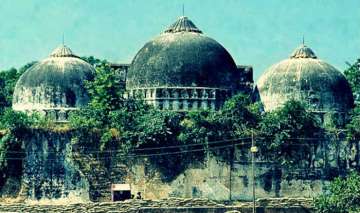Ayodhya land case: Long wall, circular shrine part of temple, not Idgah, says ex-ASI director K.K. Muhammed
Muhammed, who was on the team that carried out the digging, rubbished Muslim parties' claims before the Supreme Court that the "long wall" found during the excavations by the ASI was scientifically examined.

The long wall and circular shrine discovered during the excavation at the disputed site in Ayodhya, was part of a Hindu temple and not of an Idgah Masjid or Kannati Masjid," said K.K. Muhammed, former regional director - North, Archaeological Survey of India (ASI).
Muhammed spoke to IANS on two crucial aspects in the Ayodhya dispute - archaeological evidence and corroborated literary evidence.
Muhammed, who was on the team that carried out the digging, rubbished Muslim parties' claims before the Supreme Court that the "long wall" found during the excavations by the ASI was scientifically examined.
"Archaeology is a science and ASI is an independent agency, and it submitted a scientific report to the Allahabad High Court. If the wall were to be an Idgah or part of an Islamic structure, then how will you explain the recovery of terracotta (sculptures of god and goddesses) and 'makara pranali', the image of a crocodile, which is a symbol of river Ganga. These are not part of Islamic culture," Muhammed told IANS.
The ASI initially conducted a ground penetrating radar (GPR) survey of the disputed site to find out if there was a structure below the Babri Masjid.
"The Masjid was not built on virgin soil and the ASI report established it scientifically. The imagery of living beings is not integral to Islamic religious places. The huge wall and pillars date back to a temple, which existed there around 12th century AD," added Muhammed vouching for the existence of a temple below the Babri Masjid.
The Muslim parties have argued that the wall, which dates back to the 12th century AD, was on the western side, away from habitation and had lime-surki plastering inside it indicating its Islamic origins and that it may have been part of an Idgah.
The Muslim parties have also contested the Hindu groups' argument that the wall was part of the temple.
Clarifying ASI findings on the circular shrine recovered during the excavations, Muhammed said it was not Islamic in nature and dated back to 10th century. "This circular shrine cannot be part of Idgah, which is generally a very large congregation area. This shrine is part of the Hindu temple," said Muhammed.
The Sunni Wakf Board had pointed out how the ASI report even inferred there was a circular shrine dedicated to Lord Shiva at the site.
The Board's counsel told the apex court that archaeology is an inexact science, as it involves a lot of inferring and conjecturing. "The shrine is there in the ASI report, and it is the ASI, which has been saying there was a shrine," the counsel said.
Delving on the literary evidence, Muhammed referred to travelogues of the Western travellers as a very crucial piece of evidence, along with gazetteers.
"The travelogues indicate at faith, belief and continuous worship by the Hindus. These cannot be treated as mere stories. William Finch and Joseph Tiefenthaler gave a detailed description on Hindu worship. This cannot be ignored," he added.
According to Finch, who visited India between 1607 to 1611, "The castle built four hundred years ago. Here are also the ruins of Ranichand castle and houses, which the Indians acknowledge for the great God, saying that he took flesh upon him to see the 'tamasha' of the world."
Tiefenthaler, who visited the Oudh (Ayodhya) area sometime between 1766 to 1771, referred to the visit of Hindus and their worship in the disputed site by going for "Parikrama" thrice and prostrating on the ground.
Muhammed also cited references from Ain-i-Akbari, a 16th-century document recording the administration of the Mughal Empire under Emperor Akbar to describe worship by Hindus at the disputed land. Ain-i-Akbari was written by Akbar's court historian Abul Fazal in Persian language.
"Ain-i-Akbari is a crucial literary text too, as it clearly identifies that Hindu thronged at the disputed site in big numbers to worship Lord Ram," he added.
Also, the archaeological team which conducted digging at the disputed site was a blend of people from various religions.
"There is no need to cast aspersions on the composition of the team. Hari Manjhi, one of the directors of the excavations, was a Buddhist. Zulfikar Ali, who presently is the superintending archaeologist of Chandigarh along with Ghulam Syed Khwaja and A.A. Hashmi," said Muhammed.
He said the Muslim parties were unnecessarily complicating the simple case by raising contention without any fundamental basis, as there is ample evidence that despite the Babri Masjid in place, Hindus have been visiting Ayodhya to worship Lord Ram for centuries.
ALSO READ | Ayodhya case: Supreme Court to wrap up hearing on Oct 17
ALSO READ | Ayodhya case: SC restrains Hindu side from placing fresh evidence
ALSO READ | Ayodhya case arrives at crucial phase, intense arguments expected